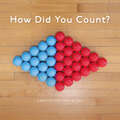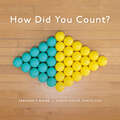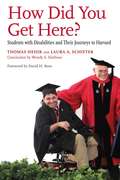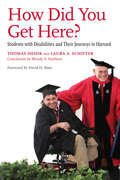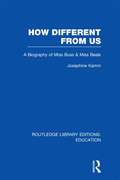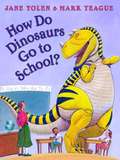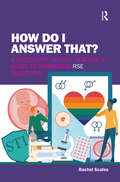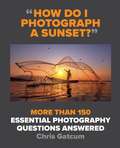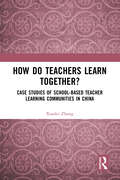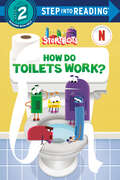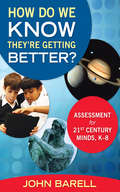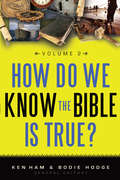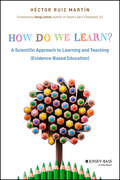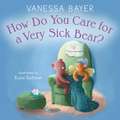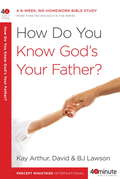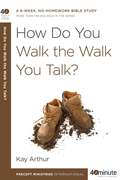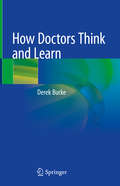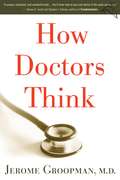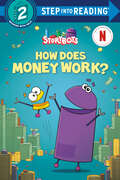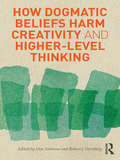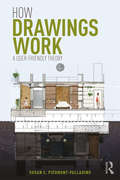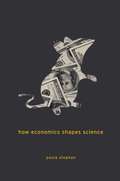- Table View
- List View
How Did You Count?: Picture Book
by Christopher DanielsonFrom the author of the award-winning Which One Doesn’t Belong? and How Many? comes How Did You Count?, the latest title in Christopher Danielson’s collection that is sure to spark conversation, questioning and wondering amongst both younger and older students alike.This listing is for a hard cover copy of the children's picture book.
How Did You Count?: Teacher's Guide
by Christopher Danielson“I hope that this Teacher’s Guide supports your own inquiry into children’s mathematics, and I hope that the images elicit brilliance from the children you do math with—wherever you and they may count.”From the author of the award-winning Which One Doesn’t Belong? and How Many? comes How Did You Count?, the latest title in Christopher Danielson’s collection that is sure to spark conversation, questioning, and wondering amongst both younger and older students alike.In this innovative Teacher’s Guide, Danielson gives you the tools you need to both begin and dig deeper into the How Did You Count? routine. In clear, accessible language, Danielson discusses the mathematical ideas likely to emerge on each page of the How Did You Count? picture book and helps you anticipate and understand your students’ likely answers. Through classroom stories, he models listening to, talking about, and delighting in students’ ideas around counting, numbers, and operations.Reading this Teacher’s Guide alongside your copy of the How Did You Count? children’s picture book will help you and your students discover together how the beauty of counting and numerical relationships and structure extends far beyond 1, 2, 3.Note: This Teacher's Guide is currently available as part of the Teacher's Guide and How Did You Count? picture book bundle.
How Did You Get Here? Students with Disabilities and Their Journeys to Harvard
by Thomas Hehir Laura A. SchifterA compelling and practical book, How Did You Get Here? offers clear accounts not only of the challenges and biases facing young disabled students, but also of the opportunities they found, and created, on the way to academic and personal success.
How Did You Get Here?: Students with Disabilities and Their Journeys to Harvard
by David Rose Thomas Hehir Wendy S. Harbour Laura A. SchifterWhen their children were young, several parents interviewed in this book were told "you can't expect much from your child." As they got older, the kids themselves often heard the same thing: that as children with disabilities, academic success would be elusive, if not impossible, for them. How Did You Get Here? clearly refutes these common, destructive assumptions. It chronicles the educational experiences--from early childhood through college--of sixteen students with disabilities and their paths to personal and academic success at Harvard University. The book explores common themes in their lives--including educational strategies, technologies, and undaunted intellectual ambitions--as well as the crucial roles played by parents, teachers, and other professionals. Above all, it provides a clear and candid account--in the voices of the students themselves--of what it takes to grapple effectively with the many challenges facing young people with disabilities. A compelling and practical book, How Did You Get Here?offers clear accounts not only of the challenges and biases facing young disabled students, but also of the opportunities they found, and created, on the way to academic and personal success.
How Did You Get Here?: Students with Disabilities and Their Journeys to Harvard
by Thomas Hehir Wendy S. Harbour Laura A. SchifterWhen their children were young, several parents interviewed in this book were told &“you can&’t expect much from your child.&” As they got older, the kids themselves often heard the same thing: that as children with disabilities, academic success would be elusive, if not impossible, for them. How Did You Get Here? clearly refutes these common, destructive assumptions. It chronicles the educational experiences—from early childhood through college—of sixteen students with disabilities and their paths to personal and academic success at Harvard University. The book explores common themes in their lives—including educational strategies, technologies, and undaunted intellectual ambitions—as well as the crucial roles played by parents, teachers, and other professionals. Above all, it provides a clear and candid account—in the voices of the students themselves—of what it takes to grapple effectively with the many challenges facing young people with disabilities. A compelling and practical book, How Did You Get Here?offers clear accounts not only of the challenges and biases facing young disabled students, but also of the opportunities they found, and created, on the way to academic and personal success.
How Different From Us: A Biography of Miss Buss and Miss Beale (Routledge Library Editions: Education)
by Josephine KammFrances Mary Buss, who began her teaching career at fourteen, was only twenty-three when she founded the North London Collegiate School, the forerunner and model of Girls’ High Schools throughout the country. Her friend Dorothea Beale was for nearly fifty years Principal of Cheltenham Ladies College, which she changed from an insignificant local school into a school and college with a comprehensive teacher training department and with upwards of a thousand pupils. She was also the founder of St.Hilda’s College, Oxford. Imbued with strong religious principles and endowed with immense energy and industry, the two women exercised a powerful influence on the development of women’s education in Britain. Yet both had to contend with bitter opposition and disillusionment. This is the first joint biography of Miss Buss and Miss Beale and it gives a fascinating comparison of their methods and widely differing characters. The author had access to hitherto unpublished material, and gathered information from pupils of both schools and from others who knew the two headmistresses, ensuring that the book, whilst full of anecdotes, is also authoritative.
How Do Dinosaurs Go to School?
by Jane YolenWhat would you do if a very large ceratosaurus stomped into your classroom? And what if the student sitting next to you was a gigantic silvisaurus -- who decided to jump on top of his desk? Come along for a very unusual day where dinosaur show-and-tell, story time, and recess antics will make even the best-behaved young dinosaurs laugh aloud. School has never been so much fun!
How Do I Answer That?: A Secondary School Teacher's Guide to Answering RSE Questions
by Rachel ScalesWhen it comes to those difficult questions about sex and relationships, how do you strike the balance between an answer that is professional but open, correct but doesn’t create panic? Aimed at secondary teachers and trainees, as well as being useful for parents and those working in charities and the voluntary sector, this book covers all the mandatory topics of the new RSE curriculum. Each chapter includes a full list of the questions to be tackled, teacher guidance highlighting important points, and model answers. Diagrams and photos are included to aid understanding and there is helpful signposting to further reading. Potentially unfamiliar topics, such as laws surrounding sexting and LGBTQ+ terminology, are clearly explained and common misconceptions and myths are dispelled.Based on years of experience, this handy text provides clear answers to the questions young people ask about RSE to help you increase your knowledge, gain confidence and ensure pupils receive the most accurate and up to date information.
How Do I Photograph A Sunset?: More than 150 essential photography questions answered
by Chris GatcumHow do we learn? We learn by asking questions. But what if we don't know what questions we should be asking? Thanks to the digital revolution, photography has never been so popular, and whether you shoot on a phone or a top-spec DSLR or CSC camera, the urge to improve is relentless. In this book, author Chris Gatcum asks the questions that every photographer will have in mind at some point in their image-making journey, and then answers them in a clear, concise, straightforward and inspirational manner. Laid out in intuitive sections, this book tackles the questions that are on every photographer's mind, as well as those that they haven't thought of yet. And with a clear progression through each chapter, from the simple to more complex, the book asks - and answers - questions to satisfy the complete novice as well as the advanced practitioner.
How Do I Photograph A Sunset?: More than 150 essential photography questions answered
by Chris GatcumHow do we learn? We learn by asking questions. But what if we don't know what questions we should be asking? Thanks to the digital revolution, photography has never been so popular, and whether you shoot on a phone or a top-spec DSLR or CSC camera, the urge to improve is relentless. In this book, author Chris Gatcum asks the questions that every photographer will have in mind at some point in their image-making journey, and then answers them in a clear, concise, straightforward and inspirational manner. Laid out in intuitive sections, this book tackles the questions that are on every photographer's mind, as well as those that they haven't thought of yet. And with a clear progression through each chapter, from the simple to more complex, the book asks - and answers - questions to satisfy the complete novice as well as the advanced practitioner.
How Do Teachers Learn Together?: Case Studies of School-based Teacher Learning Communities in China
by Xiaolei ZhangBased on case studies of Chinese teachers in Shanghai and their workplace learning within the context of reform, this book examines how Chinese teachers learn together when they engage in school-based learning activities. Since the New Curriculum Reform in China in 2001, school-based teaching research groups (TRGs) (Jiaoyanzu) have played an important role in changing teacher learning approaches. Informed by organizational learning frameworks and organizational knowledge theory, the author examines the processes and effects of teacher learning in school-based settings, particularly the role of school leadership in the learning and change of in-service teachers. Implications of sustainably optimizing the school-based teacher learning communities for school improvement are also discussed. The book will be helpful and valuable for policymakers, school leaders, researchers, students, teachers, and other educational practitioners in understanding the distinctive features of school-based teachers’ learning in China.
How Do Toilets Work? (Step into Reading)
by Random HouseThe robots from Netflix's Ask the StoryBots star in an all-new Step 2 Step into Reading leveled reader about how toilets work.We use the toilet every day, but how does it work—and where does our waste go? Join the StoryBots for an amazing adventure into the toilet, through the plumbing, and beyond. What they learn will fascinate children ages 4 to 6 who love Netflix's educational show.Step 2 Readers use basic vocabulary and short sentences to tell simple stories. For children who recognize familiar words and can sound out new words with help. Check out the other book in the series:Tyrannosaurus RexTriceratopsVelociraptorsThe Moon&’s Turn to ShineStop That Virus!
How Do We Know They’re Getting Better?: Assessment for 21st Century Minds, K–8
by John F. BarellBoost your students’ 21st century skills How do we know if we are sufficiently preparing the students of today for the challenges of the 21st century? To answer this question, John Barell explains how inquiry leads to problem-solving and provides specific steps for pre, formative and summative assessment that informs instruction of 21st century skills. Included are examples that show how to use today’s technology in the classroom and how to use inquiry to develop and assess students’ ability to: Think critically and creatively Collaborate with others Become self-directed learners Adapt and become resourceful Develop a sense of leadership, responsibility, and global awareness
How Do We Know the Bible is True? Volume 2
by Ken Ham Bodie HodgeIf you were asked how you know the Bible is true, do you have an answer? Over 29 issues addressed, including: Who made God; where did God come from? Has Noah's ark been found? Hasn't Bible text been changed over the years? Is Hell real? Did the ten plagues of Egypt really happen? We are an increasingly skeptical society -- whether it comes to politics, science, or even faith. People see conflict everywhere, even about fundamental aspects of the Bible. When church leaders are at odds about biblical truth and scriptural authority, believers are left confused and uncertain, needing clear biblical truth. Addressing topics from popular culture like the Shroud of Turin, or "missing" books of the Bible, and even what makes God's Word unique among holy books, How Do We Know the Bible is True? Vol. 2 is a "must have" resource for churches, libraries, and home study.
How Do We Learn?: A Scientific Approach to Learning and Teaching (Evidence-Based Education)
by Héctor Ruiz MartínGo beyond personal experience and discover scientific principles that will elevate your teaching The international bestseller How Do We Learn? decodes years of cognitive science research into actionable strategies for K-12 teachers, curricula designers, and administrators. You'll discover how classic and emerging findings can transform pedagogy by pointing at practices that take advantage of the innate structures of the human brain. Written in an easy-to-understand style, this book delves into the cognitive mechanisms that govern learning and memory. You'll also discover the socioemotional factors that influence students' motivation and performance. Researchers have investigated key teaching methods such as feedback and evaluation to identify how school environments influence self-motivation to learn. In this book, Héctor Ruiz Martín unites scientific principles with personal engagement, helping teachers ensure that students can thrive in the classroom and beyond. Learn how students learn so you can help them achieve academic success Get practical tips and strategies for aligning your teaching with scientific evidence Gain fascinating insights into the human mind and discover how to promote student achievement through socioemotional engagement Help students feel motivated and achieve at their best How Do We Learn? offers rigorous scientific insights—explained in accessible terms and translated into actionable steps that K-12 teachers in all disciplines can put into practice right away.
How Do You Care for a Very Sick Bear?
by Vanessa BayerFrom debut children's author Vanessa Bayer and illustrator Rosie Butcher, How Do You Care for a Very Sick Bear? is a sweet picture book with advice for children—and adults—for dealing with a sick friend.You and your friend Bearare an excellent pair.But if your friend gets sick, And can’t do all the things that you two love to do…You may wonder--how do you care for a very sick Bear?When someone dear is dealing with illness, it's difficult to know what to do or say. The actor Vanessa Bayer experienced this firsthand when she was treated for childhood leukemia. In her first children's book, she offers gentle, reassuring advice that people of all ages will appreciate.
How Do You Know God's Your Father?
by Kay Arthur David Lawson B J LawsonThis brand new Bible study series from beloved Bible teacher Kay Arthur and the teaching staff of Precept Ministries tackles important issues in brief, easy-to-grasp lessons you can benefit from personally or as part of a small group. Each book in the series includes six 40-minute studies designed to draw you into God’s Word through basic inductive Bible study. As Kay explains, "Rather than simply reading or listening to what others say about a subject, you are going to see for yourself what God says about it. "Join one of the world’s most respected Bible teachers in a study that will revolutionize your thinking--and your life. You are surrounded by a world that’s watching you, waiting to see if what you say is true--if you really believe what you say and “walk the walk you talk. That thought may seem overwhelming, even intimidating. But Kay Arthur is ready to guide you into a deeper understanding of God’s Word. This study of vital passages from Ephesians will help you discover what God says about the lifestyle of a true believer. And it will equip you to live in a manner worthy of your calling--with the ultimate goal of developing a life marked by maturity, Christlikeness, and peace. Get started on an authentic walk with God that matches your talk. Kay Arthur will show you the way. From the Trade Paperback edition.
How Do You Walk the Walk You Talk? (40-Minute Bible Studies)
by Kay ArthurThis brand new Bible study series from beloved Bible teacher Kay Arthur and the teaching staff of Precept Ministries tackles important issues in brief, easy-to-grasp lessons you can benefit from personally or as part of a small group. Each book in the series includes six 40-minute studies designed to draw you into God’s Word through basic inductive Bible study. As Kay explains, "Rather than simply reading or listening to what others say about a subject, you are going to see for yourself what God says about it. "Join one of the world’s most respected Bible teachers in a study that will revolutionize your thinking--and your life. You are surrounded by a world that’s watching you, waiting to see if what you say is true--if you really believe what you say and “walk the walk you talk. That thought may seem overwhelming, even intimidating. But Kay Arthur is ready to guide you into a deeper understanding of God’s Word. This study of vital passages from Ephesians will help you discover what God says about the lifestyle of a true believer. And it will equip you to live in a manner worthy of your calling--with the ultimate goal of developing a life marked by maturity, Christlikeness, and peace. Get started on an authentic walk with God that matches your talk. Kay Arthur will show you the way. From the Trade Paperback edition.
How Doctors Think and Learn
by Derek BurkeThis book describes the theoretical basis for the acquisition; development and refining of professional medical skills from entry level into professional training to those developing specialist expertise. Chapters review the presently available literature on educational theory, the cognitive processes underpinning memory and learning, skill acquisition, competence and assessment and reflection. A synthesis is also presented on why a particular theoretical foundation model of professional skill acquisition should be adopted based on the current understanding of traditional educational theory, theories of cognitive development and neurophysiology. How Doctors Think and Learn details the theoretical basis for acquiring and developing professional medical skills and is an essential resource for all those who deliver medical education, training and professional development.
How Doctors Think: How Doctors Think
by Jerome GroopmanOn average, a physician will interrupt a patient describing her symptoms within eighteen seconds. In that short time, many doctors decide on the likely diagnosis and best treatment. Often, decisions made this way are correct, but at crucial moments they can also be wrong -- with catastrophic consequences. In this myth-shattering book, Jerome Groopman pinpoints the forces and thought processes behind the decisions doctors make. Groopman explores why doctors err and shows when and how they can -- with our help -- avoid snap judgments, embrace uncertainty, communicate effectively, and deploy other skills that can profoundly impact our health. This book is the first to describe in detail the warning signs of erroneous medical thinking and reveal how new technologies may actually hinder accurate diagnoses. How Doctors Think offers direct, intelligent questions patients can ask their doctors to help them get back on track.Groopman draws on a wealth of research, extensive interviews with some of the country’s best doctors, and his own experiences as a doctor and as a patient. He has learned many of the lessons in this book the hard way, from his own mistakes and from errors his doctors made in treating his own debilitating medical problems.How Doctors Think reveals a profound new view of twenty-first-century medical practice, giving doctors and patients the vital information they need to make better judgments together.
How Does Echolocation Work?
by Scott ForesmanBy the time your child reaches Reading Street: Grade 4, he or she is ready to learn more complex English and Language Arts skills. This set of homeschool program materials is packed with educational activities, lesson ideas, reading assignments and quizzes to help your child rise to the next step in his or her academic career. The Grade 4 system is not only designed as a learning tool for children, but as a guide for you as the teacher. Use the materials included in the set to form unique, fun and engaging lesson plans for your child. The comprehensive structure of Reading Street: Grade 4 makes it easy to use. The curriculum for homeschooling comes with two volumes of content that are broken down into weekly lessons. Each week centers on a Big Idea or key concept. Your child will complete writing tasks, reading assignments, quizzes and discussions that relate back to the Big Idea. By the time your child completes Grade 4 of Reading Street, he or she should be able to: Explain character motives, central themes and specific events within a text. Comprehend the meaning of unfamiliar words using context clues. Break down poems by verses. Identify different types of literature, such as prose, poetry and drama. Use introductions and conclusions in writing. Cite sources in writing if necessary. Prepare and present oral presentations. Reading Street: Grade 4 transitions flawlessly into more challenging content to help your child expand his or her English and Language arts skills. The material is all uniform in design, making it easy for you and your child to navigate. You can use the components in the Teacher Resource DVD to create dynamic lessons for your child. Print out worksheets, use the provided games and incorporate the writing prompts as you teach your child. The structure of the Reading Street sets is straightforward and easy to follow. You'll know exactly how much you've accomplished in your child's education as you progress, and you'll be able to keep track of his or her Grades without difficulty.
How Does Money Work? (Step into Reading)
by Scott EmmonsThe robots from Netflix's StoryBots Answer Time star in an all-new Step 2 Step into Reading leveled reader!Bing wants to know what money is and why we use it. His questions lead him from a bank to a tour of a successful lemonade stand. What he learns will fascinate children ages 4 to 6 who love Netflix's educational show.Step 2 Readers use basic vocabulary and short sentences to tell simple stories. For children who recognize familiar words and can sound out new words with help.
How Dogmatic Beliefs Harm Creativity and Higher-Level Thinking (Educational Psychology Series)
by Don Ambrose and Robert J. SternbergIn a world plagued by enormous, complex problems requiring long-range vision and interdisciplinary insights, the need to attend to the influence of dogmatic thinking on the development of high ability and creative intelligence is pressing. This volume introduces the problem of dogmatism broadly, explores the nature and nuances of dogmatic thinking from various disciplinary perspectives, and applies the gleaned insights to what is known about creativity. Bringing together leading thinkers in the fields of creative studies and education, and in other relevant fields (history, sociology, psychology) whose work pertains to the various dimensions of dogmatism and the ethical problems it generates, this panoramic view represents interdisciplinary bridge building with the potential to generate new insights about the education of creative young minds.
How Drawings Work: A User-Friendly Theory
by Susan C. Piedmont-PalladinoHow Drawings Work cheekily explains that what architects make is information that enables other people to make buildings. That information comes in a variety of forms: drawings by hand and computer, models both physical and virtual, and words as needed. The book reflects in witty prose on the nature of architectural drawings as tools of communication, pulling from a diverse and eclectic landscape of theories from grammar, functional linguistics, philosophy, art criticism, science fiction, popular culture, and, of course, architecture, to propose a new way to think about architectural communication.
How Economics Shapes Science
by Paula StephanThe beauty of science may be pure and eternal, but the practice of science costs money. And scientists, being human, respond to incentives and costs, in money and glory. Choosing a research topic, deciding what papers to write and where to publish them, sticking with a familiar area or going into something new—the payoff may be tenure or a job at a highly ranked university or a prestigious award or a bump in salary. The risk may be not getting any of that. At a time when science is seen as an engine of economic growth, Paula Stephan brings a keen understanding of the ongoing cost-benefit calculations made by individuals and institutions as they compete for resources and reputation. She shows how universities offload risks by increasing the percentage of non-tenure-track faculty, requiring tenured faculty to pay salaries from outside grants, and staffing labs with foreign workers on temporary visas. With funding tight, investigators pursue safe projects rather than less fundable ones with uncertain but potentially path-breaking outcomes. Career prospects in science are increasingly dismal for the young because of ever-lengthening apprenticeships, scarcity of permanent academic positions, and the difficulty of getting funded. Vivid, thorough, and bold, How Economics Shapes Science highlights the growing gap between the haves and have-nots—especially the vast imbalance between the biomedical sciences and physics/engineering—and offers a persuasive vision of a more productive, more creative research system that would lead and benefit the world.
